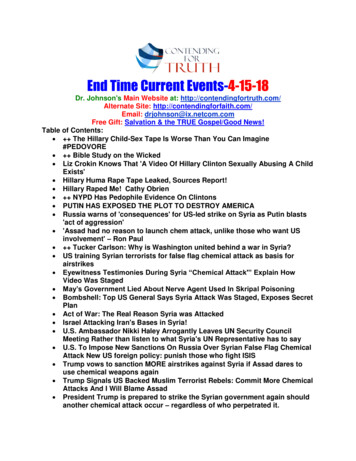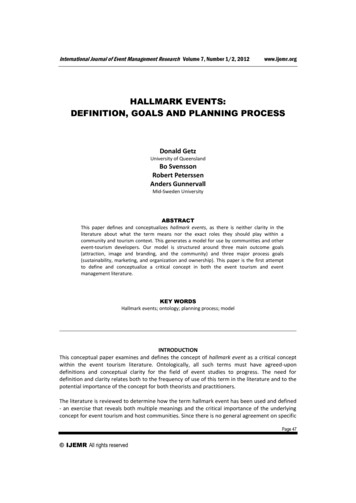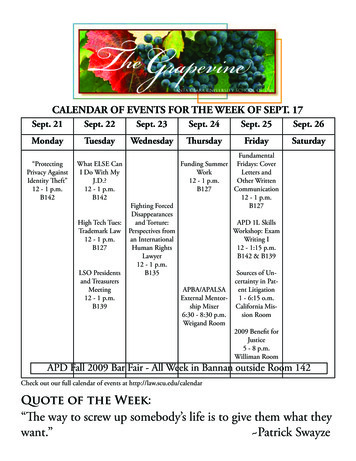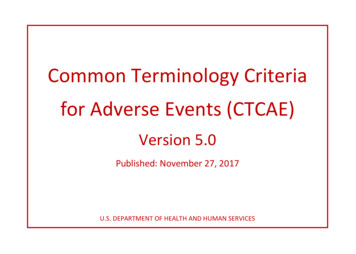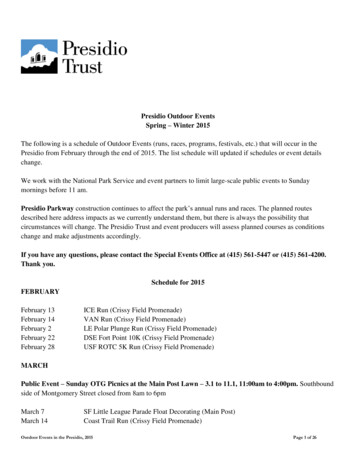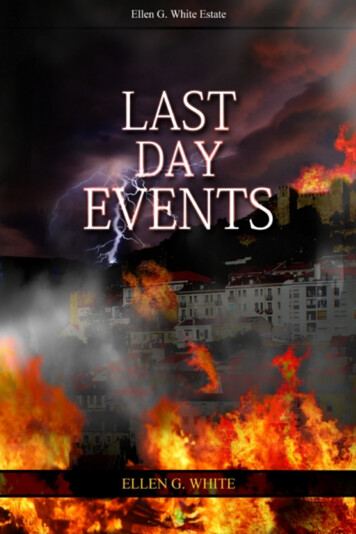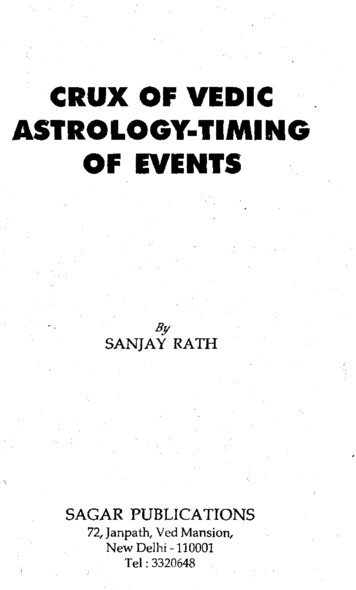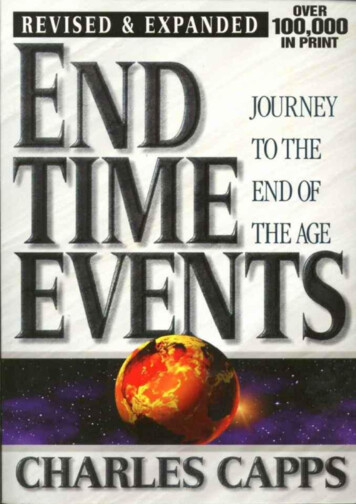
Transcription
EUROPEAN ACADEMIC RESEARCHVol. II, Issue 5/ August 2014ISSN 2286-4822www.euacademic.orgImpact Factor: 3.1 (UIF)DRJI Value: 5.9 (B )Interdiscursive events misrepresentation in I amMalala: A Critical Discourse analysisAALIA FIRDOUSTANIA AFZALSABAHT MUSHTAQRiphah International University, FaisalabadPakistanAbstract:The present article deals with the book “I am Malala”. Thecertain extracts are selected to unveil the explicit and implicit voiceswhich are louder than Malala’s own voice. For this study Fairclough’sthree dimensional theoretical framework of CDA is chosen. Throughqualitative data analysis other voices are unveiled and it is alsorevealed that how interdiscursive events represent half reality or oneside of the picture. This study proves that through voices andinterdiscursive events, the boundary of education and peace is blurred.Other discourses as history, culture terrorism, politics, poverty,feminism, and marginalization are popping up more than education.Key words: interdiscursive, politics, voices, peace, history.BackgroundAn idyllic valley rich in natural resources and heritage locatedin northwestern Pakistan, Swat was a princely state until itwas merged into Pakistan in 1969. Its benevolent rulersdeveloped a network of educational institutions, clinics,libraries and recreation centers for the locals. Mingora is notonly the administrative capital of Swat Valley; it is also themain center of social, cultural and economic activities in the6398
Aalia Firdous, Tania Afzal, Sabaht Mushtaq- Interdiscursivemisrepresentation in I am Malala: A Critical Discourse analysiseventsMalakand region. It is a beautiful city with moderate weatherand tourist attractions. Since the time of the Swat State (19151969) tourists from inside and outside the country stayed inMingora before moving to the upper valleys of Swat. The city isalso home to rare Buddhist ruins and stupas. According to 1998census 175,000 people reside in Mingora. Apart from the localYousafzai tribe of the Pashtuns (predominantly Muslim), Hinduand Sikh families also live in the city giving diversity to itscultural life. The rise of the Taliban insurgency in 2007changed the traditional pattern of life in Mingora. Fazlullah, aformer lift operator turned militant commander, launched apirated FM channel in Mamdheri village, at a distance of barely5 KM from Mingora. In 2008 his campaign against girls’education, anti-polio treatments and liberal expressions of lifeleft the city and its residents with serious challenges for theirsurvival. The Green Square of the city, once the hub of socialand cultural activities, turned into a “bloody square” where thedead bodies of Taliban opponents, police and civil societyworkers were hung from electricity poles. Pakistan launched amilitary action against the Taliban in 2009. (Buneri, 2012).The conflict between the security forces and the Talibandisplaced 2.5 million people from Malakand, of which Swat is adistrict. The city became a battleground and, by the end of theyear, a number of buildings were destroyed. The power supplycenter had been bombed by the Taliban. The military operationpushed the Taliban to the mountainous area along the PakAfghan border close to the upper Dir district and Bajaur tribalagency. According to the military, 128 soldiers and at least1,475 militants were killed and 317 soldiers were woundedduring operation Black Thunderstorm. 95 soldiers andpolicemen were captured by the militants, 18 of them wererescued while the fate of the others remained undetermined.114 militants were captured, including some localcommanders. At least 23 of the militants killed were foreigners.EUROPEAN ACADEMIC RESEARCH - Vol. II, Issue 5 / August 20146399
Aalia Firdous, Tania Afzal, Sabaht Mushtaq- Interdiscursivemisrepresentation in I am Malala: A Critical Discourse analysiseventsIntroductionI am Malala, is Malala Yousafzai’s autobiography, co-writtenwith journalist Christina Lamb, begins on Malala's drive homefrom school on the day she was shot in the head. "Who isMalala?" the young gunman who stopped the Khushal schoolvan asked. None of the girls answered. But everyone in thevalley knew who Malala was. Ten years old when the Tehrik-eTaliban Pakistan came to the beautiful Swat Valley, once thehome of ancient Buddhist kings, 11 years old by the time shehad established herself as an international advocate for girls'education in Pakistan, Malala was targeted by the Taliban for"spreading secularism”. In "I am Malala" the discourse ofeducation and peace welcome us on the very title page, “The girlwho stood up for education and was shot by the Taliban.”(Yousafzai, 2013) Yet inside the book we come across that it isnot only Malala who raised her voice as she herself claims atthe end of the book “A Note On The Malala’s Fund” rather othervoices explicitly and implicitly are prominent and besideeducation, directly or indirectly, many important institutions ofPakistan are discussed /criticized. So one gets totally confusedwhether this book really advocates education ardently or otherissues are more considerable, one can easily find the ampledetail of Pakistan's political history, diverse ethnic culture ,even in language code mixing and code switching are prominenttechniques, that testify multicultural society with differentdialects. It is tried by co-writer to create cohesion in book butrandom details of history sometimes fail this attempt. Poverty,Climate change, Flood and Earthquake are some otherdiscourses in this book.HypothesisOther voices are louder than Malala’s own voice in “I amMalala”.EUROPEAN ACADEMIC RESEARCH - Vol. II, Issue 5 / August 20146400
Aalia Firdous, Tania Afzal, Sabaht Mushtaq- Interdiscursivemisrepresentation in I am Malala: A Critical Discourse analysiseventsInterdiscursive events blur the boundaries of education andpeace.Interdiscursive events represent one side of certain facts in “Iam Malala”?Research QuestionsDoes "I am MALALA" purely advocate noble cause ofeducation?Are explicit and implicit voices louder than Malala’s own voice?How certain interdiscursive events represent one side of certainfacts in I am Malala?Objectives of the StudyTo find out explicit and implicit voices than Malala’s own voice.To reveal other interdiscursive events with full representationof facts.Theoretical FrameworkCDA MethodologyCDA is as an approach, constituted of different theorists withdifferent emphases, follows that the methodology of actualanalytical tools should be diverse. Here, however, the diversityis not so much of social theory but rather on analyticalpreference given the nature of the text or subject matter. MostCDA theorists from different theoretical backgrounds find theFairclough’s three-tier framework useful. It has three stages.Description is the stage which is concerned with the formalproperties of the text.Interpretation is concerned with the relationship betweentext and interaction – with seeing the text as a product of aEUROPEAN ACADEMIC RESEARCH - Vol. II, Issue 5 / August 20146401
Aalia Firdous, Tania Afzal, Sabaht Mushtaq- Interdiscursivemisrepresentation in I am Malala: A Critical Discourse analysiseventsprocess of production, and as a resource in the process ofinterpretation.Explanation is concerned with the relationship betweeninteraction and social context with the social determination ofthe processes of production, and as a source in the process ofinterpretation.(Fairclough, 1995)Fairclough’s model brings together all the important elementsthat would constitute a CDA analytical method. At the centrelies the core aspect of the analysis: the text or communicativeevent that could be a news article, a speech, a website thatcould include ‘verbal, visual or verbal and visual texts’ (Janks1998, 1). Here one would apply linguistic analysis and semioticanalysis, where you could focus on ‘argumentation, narrative,modality, transitivity [or wording], nominalization, voice’(Fairclough 2005, 81). The focus here is on describing the text,the story or argument that is being made, who is speaking, towhom as the style that is being used. The purpose is to try tosee patterns at work in the text looking at sentence structuresand how verbs and nouns are used ‘to establish hypothesesabout discourses at work in society’ (Janks 2005, 331). Some ofthe patterns are apparent in Fairclough’s three ‘categories offunction’ operating in texts: the ‘ideational, interpersonal andtextual’ (1995, 58). By ideational he means the representationsEUROPEAN ACADEMIC RESEARCH - Vol. II, Issue 5 / August 20146402
Aalia Firdous, Tania Afzal, Sabaht Mushtaq- Interdiscursivemisrepresentation in I am Malala: A Critical Discourse analysiseventsof society or ideology present in the text. The interpersonalrefers to how identity is shaped of both writer and reader. Thetextual refers to the style(s) or genre(s) of the text. The analystdoes not only focus on what is present in the text but also whator who has been excluded or omitted.The third box of Fairclough’s framework looks at thelarger social context of the text in focus. What are the broadersocio-political factors (or even historical issues) contextualisethis communicative event? What broader societal (or evenglobal) power regimes does it reinforce, normalise orundermine? The analysis has now moved from textual analysis,to interpretation and the second box marks the level ofdiscursive analysis or interpretation of the text. Here theanalyst looks at all the possible discourses at play in the textboth from the perspective of the writer or producer orinstitution and the (preferred) reader or audience. If it is, forexample, a news article the analyst will look at professionalpractices, the newspaper ownership or position, the impact ofadvertising and so on. The analyst here is trying to make senseof the text by looking at the various discursive regimes that areimplicit in the text. One could, for example, depending on thetextual form and its content deploy other theoretical tools tohelp illuminate particular regimes of power. Mamdani (1996)has been used to illustrate how individuals could be positionedas both ‘subjects’ and ‘citizens’ in Africa as a result of the dualsystems of government under colonialism (Prinsloo 2007, 82).Thompson (1990) has been mined for his five modes ofoperation of ideology (namely legitimating, dissimulation,unification, fragmentation and reification) (Janks 1998, 199200).Finally an attempt to ‘look for patterns across textsrelated so as to form an ‘order of discourse’, or fordiscontinuities and hybridity which can signal disorder andsocial change’ (Janks 1998, 197).EUROPEAN ACADEMIC RESEARCH - Vol. II, Issue 5 / August 20146403
Aalia Firdous, Tania Afzal, Sabaht Mushtaq- Interdiscursivemisrepresentation in I am Malala: A Critical Discourse analysiseventsAn important technique to bear in mind when applying theabove framework is the notion of engagement andestrangement. Estrangement is to be outside of the discourse ofthe preferred reader of the text and facilitates a criticalreading. Engagement is to grasp and identify with thepositioning of the subject as implied in the text and this helpsto understand the impact of the discourse. Both these positionshave their advantages and impediments. CDA requires a movebetween these positions to get a more rounded analysis ‘andargues the need for reading against the text to counterbalancereading with the text’ (Janks 2005, 331).Literature ReviewInterdiscursivity refers to the mixing of diverse genres,discourses, or styles associated with institutional and socialmeanings in a single text. This linguistic phenomenonpermeates through language use, especially in contemporaryinstitutional settings. A case in point can be found in amediating event, in which three kinds of activities, namely, thedisputing parties, bargaining and inquiring, the mediator’soffering of law knowledge and voicing of advice, intermingle inthe process to achieve settlement. Thus, it can be seen asinterdiscursive through the hybridity of three genres:bargaining, counseling, and therapeutic. It must be admittedthat the phenomenon of interdiscursivity exists in manydifferent forms and the ways of understanding vary a lotamongst researchers.(WU, 2011)Interdiscursivity versus IntertextualityGenerally, intertextuality refers to the phenomenon that othertexts are overtly drawn upon within a text, which is typicallyexpressed through explicit surface textual features such asquotations and citations. Actually, all texts are constituted ofelements of other texts and use such intertextual resources toEUROPEAN ACADEMIC RESEARCH - Vol. II, Issue 5 / August 20146404
Aalia Firdous, Tania Afzal, Sabaht Mushtaq- Interdiscursivemisrepresentation in I am Malala: A Critical Discourse analysiseventsvarying degrees and for various purposes. Interdiscursivity,however, operates on a different dimension in that. It refers tohow a text is constituted by a combination of other languageconventions (genres, discourses and styles). Thus the differencebetween these two concepts is that intertextuality refers toactual surface forms in a text, borrowed from other texts;whereas interdiscursivity involves the whole language systemreferred to in a text. In this sense, interdiscursivity is morecomplicated because it is concerned with the implicit relationsbetween discursive formations rather than the explicit relationsbetween texts. (WU, 2011)Interdiscursivity versus Generic IntertextualitySome scholars (e.g. Xin 2000: 191) have used the term "genericintertextuality" to cover what interdiscursivity actually refersto. However, these two notions do not always have the sameconnotation in the sense that interdiscursivity does not alwaysrefer to the mixing of different genres. In some cases, it is thearticulation of discourses or of styles that makes sense in theformation of interdiscursive relations. Although genre is anoverarching term among the three elements (genres, discoursesand styles) and the relationship between them is dialectical, itneeds to be clarified that generic intertextuality cannot beequated with interdiscursivity. (WU, 2011)Interdiscursivity versus HeteroglossiaInterdiscursivity is grounded on Bakhtin’s (1981, 1986) notionof heteroglossia. Bakhtin (1981: 291) holds a heteroglossic viewthat any text is a combination of one’s own voice and the voicesof others. Thus we can see heteroglossia is a phenomenon thatproduces social heterogeneity. Later on, heteroglossia wasrecontextualized by Fairclough (1992) as interdiscursivity, withthe ideological flavor highlighted at the same time. ForFairclough, interdiscursivity is more ideological thanheteroglossia in the sense that the tracking of ideology is aEUROPEAN ACADEMIC RESEARCH - Vol. II, Issue 5 / August 20146405
Aalia Firdous, Tania Afzal, Sabaht Mushtaq- Interdiscursivemisrepresentation in I am Malala: A Critical Discourse analysiseventsmore specific task for interdiscursivity than in Bakhtin's works.For Bakhtin, every speech act betrays an ideology or ideologiesissuing from individual speakers in the context of a givendialogue. (WU, 2011)Interdiscursivity versus DialogicalityThe Bakhtinian notion dialogicality is closely related tointerdiscursivity and sometimes the two terms are usedinterchangeably in the literature of discourse analysis.According to Bakhtin (1981, 1986), all texts are dialogic andmust be understood against the background of other texts onsimilar or related topics. Texts and utterances are not thewriter or speaker’s own products; they usually contain othervoices — explicit or implicit elements from other sources,including genres, discourses and styles from other languageconventions, through which interdiscursivity can be formed.Nevertheless, in application, these two notions shouldpreferably be differentiated: dialogicality is a property of thesubject matter of human being and cultural sciences, whileinterdiscursivity is a property of text that takes dialogicalitysystematically into consideration. A tendency to dialogicality,taken as the ability to indulge in dialogue, is an innate humanproperty since man is a semiotic animal. Therefore,dialogicality is a much more general property or principle scursivity is a relatively specific linguistic phenomenonthat bears social significance. Moreover, these two notions areused in different situations. Dialogicality is perhaps mostfamiliar in the analysis of the literature, arts and scholarlytexts, in which we can talk about not only dialogical relationswithin a given text or piece of art or music, but also dialoguebetween generations of texts and authors (artists, composers,etc.). By contrast, interdiscursivity is generally applied to bothliterary and nonliterary texts, which focuses on the dialogicalrelations between different language conventions related toEUROPEAN ACADEMIC RESEARCH - Vol. II, Issue 5 / August 20146406
Aalia Firdous, Tania Afzal, Sabaht Mushtaq- Interdiscursivemisrepresentation in I am Malala: A Critical Discourse analysiseventscertain social tendencies or ideological significances.Interdiscursivity is a notion of the Bakhtinian tradition inliterature (also made available, e.g. in France, by Kristeva),with piecemeal researches in stylistics and CDA, more usuallyas a special kind of intertextuality. In this part we will brieflytrace the origin of interdiscursivity so as to better understandits modern manifestations. We will also review in brief thedifferent approaches of the study and try to present an objectivecomment on each of them. This will help to achieve a clearmodel from a pragmatic perspective for the present study. (WU,2011)Interdiscursivity as a Special Kind of IntertextualityThe term interdiscursivity was coined by Fairclough (1992)when he accounted for the more overarching concept ofIntertextuality. He defines intertextuality basically as theproperty texts have of being full of snatches of other texts,which may be explicitly demarcated or merged in, and whichthe text may assimilate, contradict, ironically echo, and so forth(Fairclough 1992: 84). Drawing upon Bakhtin’s (1986) work,Fairclough (1992) further introduces the classification ofintertextuality by French discourse analysts, namely, "manifestintertextuality" and "constitutive intertextuality". Manifestintertextuality refers to the explicit presence of one text inanother through the techniques of discourse representation,presupposition, negation, metadiscourse and/or irony.Constitutive intertextuality refers to the mixing configurationof discourse conventions such as genres, activity types, andstyles associated with different types of discourse. In order toemphasize that the focus is on discourse conventions ratherthan other texts as constitutive, Fairclough introduces the newterm “interdiscursivity” to replace “constitutive intertextuality”.However, the concept of interdiscursivity can be traced toBakhtin’s dialogized “heteroglossia” (see Bakhtin 1981, 1986).For Bakhtin, language is essentially composed of utterancesEUROPEAN ACADEMIC RESEARCH - Vol. II, Issue 5 / August 20146407
Aalia Firdous, Tania Afzal, Sabaht Mushtaq- Interdiscursivemisrepresentation in I am Malala: A Critical Discourse analysiseventsrather than sentences, and utterances are always, except insome imagined ideal conditions, dialogized in the sense thateach is viewed from the perspective of the others. Such adialogization of utterances is always going on, and utterancesare always changing and result in what Bakhtin calls“hybridization” — the mixture of different utterances within asingle piece of language. Bakhtin describes this complexmixture of utterances as heteroglossia. What Bakhtin holds interms of the concept of dialogized heteroglossia brings us to theissue of interdiscursivity, and Bakhtin is more concerned withthe language in specific social situations.During the “transitional period” from structuralism topost structuralism (in the late 1960s), Kristeva introducedBakhtin’s theory into France and coined the term“intertextuality” (see Kristeva 1986, actually written in 1966).For Kristeva, intertextuality implies the insertion of history(society) into a text and of this text into history (1986: 39).Here, the Bakhtinian notions of dialogism and heteroglossiahave been rephrased within Kristeva's attention to text,textuality and their relation to society and history. Based uponKristeva's expression of intertextuality, the French discourseanalysts draw a distinction between “manifest” and“constitutive intertextuality”. The latter is highlighted byFairclough as "interdiscursivity" in order to echo Pêcheux'snotion of interdiscourse, and to foreground various elements oforders of discourse such as genres, discourses, and styles. Fromthis rather brief diachronic review, we can see that all texts areintertextual, in the sense that each utterance is a link in achain of speech communication, or that each text containswithin itself evidences of the histories of other texts. As aspecial kind of intertextuality, interdiscursivity is related to thewhole language system involved in a text. As Allen (2000)suggests, it (intertextuality or interdiscursivity in particular) isa term by no means exclusively related to the study of literaryworks or to written communication in general. (WU, 2011)EUROPEAN ACADEMIC RESEARCH - Vol. II, Issue 5 / August 20146408
Aalia Firdous, Tania Afzal, Sabaht Mushtaq- Interdiscursivemisrepresentation in I am Malala: A Critical Discourse analysiseventsInterdiscursivity in Non-Literary Texts: The CDAApproachFairclough (1992, 2003, and 2010) thinks that interdiscursivityis more than a stylistic phenomenon; rather, it has importantimplications for social practice. Thus, interdiscursivity, as wellas the constantly changing interdiscursive relations in texts, iscentral to an understanding of the process of social change.Fairclough’s study combines the constitutive view of discourseillustrated by Foucault and the dynamic view of discursivepractice as well as its relationship with social practice. Heaccounts for this phenomenon with Grimace’s conception ofhegemony and Habermas' theory of colonization of the lifeworld by social systems. Fairclough (1992: 200-224) also holdsthat the interdiscursive relations in texts can reflect the threeinterlocking Bhatia (1995, 2004) explores the cases ofinterdiscursivity in business advertising, news reporting andlegal documents, as well as in public administration andbureaucratic communications. According to him, thephenomenon of mixing “private intentions” with “sociallyrecognized communicative purposes” is characteristic of andwidely used in a number of professional domains, resulting in a“mixing” and often “blending” of genres (see Bhatia 1995). Agreat deal of such instances of mixed genres is becomingestablished and is being given innovative names such asinfomercial, infotainment or advertorial. Against thisbackground of intense interdiscursivity, Bhatia (1995: 1)explains that this dynamic complexity of professionalcommunication is the result of several factors, including theever-increasing use of multi-media, explosion of informationtechnology, multi-disciplinary contexts of the world of work,increasingly competitive professional (academic as well asbusiness) environment, and the overwhelmingly compulsivenature of promotional and advertising activities. In Worlds ofWritten Discourse, Bhatia (2004) puts forward a multiperspective four-space model of discourse analysis as aEUROPEAN ACADEMIC RESEARCH - Vol. II, Issue 5 / August 20146409
Aalia Firdous, Tania Afzal, Sabaht Mushtaq- Interdiscursivemisrepresentation in I am Malala: A Critical Discourse analysiseventsdevelopment of his own theory. Taking the generic variationand dynamism into consideration, he offers a detailed accountof interdiscursivity and its application potential in terms of theincreasing hybridization of organizational life. According toChouliaraki and Fairclough (1999), the pervasive discoursalhybridity (or interdiscursivity) in interactions and texts hasbeen widely seen as a significant characteristic of postmodernsocial life in that late modernity entails a radical unsettling ofthe boundaries of social life. They hold that interdiscursiveanalysis is an important aspect of analysis of field relations. Intheir updated five-step analytical framework of CDA (ibid.: 5966), Chouliaraki and Fairclough take interdiscursive analysisas an effective key to identifying obstacles to the resolution ofsocial problems. Wodak (2001) touches upon interdiscursivityfrom what she calls “the discourse-historical approach”studying the interdiscursive relations in texts in order to shedlight on her critical analysis of social problems such as racism,bureaucratism, and sexism, etc. She proposes to tieinterdiscursivity to transformational recontextualization andhistorical change and at the same time to focus on the potentialinterdiscursive relations through mixing of new genres. TheCDA approach to interdiscursivity has several advantages overthe stylistic approach. Firstly, it goes beyond surface analysisand can explain how and why interdiscursivity takes shape asit is and what social changes it is meant to reflect. Secondly,unlike the stylistic approach, the CDA approach takes thedynamics of communication into consideration. Thirdly, thedata in CDA is rather empirical and is tied more closely to reallanguage use in that. It is mainly collected from the authenticnon-literary discourse. (WU, 2011)MethodologyFor data analysis certain chunks are selected fromautobiographical book "I am Malala" by Malala and co-writerEUROPEAN ACADEMIC RESEARCH - Vol. II, Issue 5 / August 20146410
Aalia Firdous, Tania Afzal, Sabaht Mushtaq- Interdiscursivemisrepresentation in I am Malala: A Critical Discourse analysiseventsChristina lamb. Through qualitative data analysis approach,within CDA theoretical framework especially third level whichallows interpreting text through this analysis andinterpretation, voices and interdiscursive events are found fromthe text.DiscussionCritical Discourse Analysis of selected ExtractsFirst Extract From I Am Malala“We have many strands of Islam in Pakistan. Our founderJinnah wanted the rights of Muslims in India to be recognized,but the majority of people in India were Hindu. It was as ifthere was a feud between two brothers and they agreed to livein different houses. So British India was divided in August1947”. (Yousafzai, 2013)Here a very important interdiscursive event isrepresented; the creation of Pakistan which was not the feudbetween two brothers rather it was created on the basis of twonation theory. This two nation theory reflects simply inspeeches and views of our all great national heroes.The ideology of Pakistan stems from the instinct of theMuslim community of South Asia to maintain theirindividuality by resisting all attempts by the Hindu society toabsorb it. Muslims of South Asia believe that Islam andHinduism are not only two religions, but also two social ordersthat have given birth to two distinct cultures with nosimilarities. A deep study of the history of this land proves thatthe differences between Hindus and Muslims were not confinedto the struggle for political supremacy, but were alsomanifested in the clash of two social orders. Despite livingtogether for more than a thousand years, they continued todevelop different cultures and traditions. Their eating habits,music, architecture and script, are all poles apart. Even theEUROPEAN ACADEMIC RESEARCH - Vol. II, Issue 5 / August 20146411
Aalia Firdous, Tania Afzal, Sabaht Mushtaq- Interdiscursivemisrepresentation in I am Malala: A Critical Discourse analysiseventslanguage they speak and the dresses they wear are entirelydifferent.The movement for Muslim self-awakening and identitywas started by the Muslim modernist and reformer Sir SyedAhmad Khan (1817–1898). Many Pakistanis describe him asthe architect of the two-nation theory. However, the researcherZiauddin Lahori, the author of seven books on Sir Syed, thinksotherwise. According to him, it is incorrect to say that Sir er Muhammad Iqbal (1877–1938), (the Poet of East),provided the philosophical exposition and Barrister MuhammadAli Jinnah (1871–1948) translated it into the political reality ofa nation-state. Allama Iqbal's presidential address tothe Muslim League on December 29, 1930 is seen by some asthe first exposition of the two-nation theory in support of whatwould ultimately become Pakistan. The scholar Al-Biruni (9731048) had observed, at the beginning of the eleventh centurythat Hindus and Muslims differed in all matters and habits.QUAID-E –AZAM AND TWO NATION THEORY.On March 22, 1940, Jinnah made a speech in Lahore which wasvery similar to Al-Biruni's thesis in theme andtone. Jinnah stated that Hindus and Muslims belonged to twodifferent religious philosophies, with different social customsand literature, with no intermarriages and based on conflictingideas and concepts. Their outlook on life and of life wasdifferent and despite of 1000 years of history, the relationsbetween the Hindus and Muslims could not attain the level ofcordiality. In 1944, Jinnah said:“We maintain and hold that the Muslims and the Hindus aretwo major nations by any definition or test of a nation. We area nation of hundred million and what is more. We are nationwith our own distinctive culture and civilization, languageand literature, art and architecture, names and nomenclature,sense of values and proportions, legal laws and moral codes,customs and calendar, history and tradition, and aptitude andEUROPEAN ACADEMIC RESEARCH - Vol. II, Issue 5 / August 20146412
Aalia Firdous, Tania Afzal, Sabaht Mushtaq- Interdiscursivemisrepresentation in I am Malala: A Critical Discourse analysiseventsambitions. In short, we have our own outlook on life and oflife.”
misrepresentation in I am Malala: A Critical Discourse analysis EUROPEAN ACADEMIC RESEARCH - Vol. II, Issue 5 / August 2014 6404 An important technique to bear in mind when applying the above framework is the notion of engagement and estran
